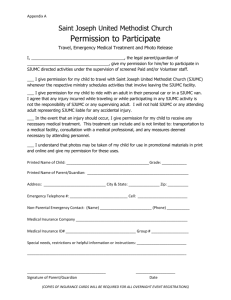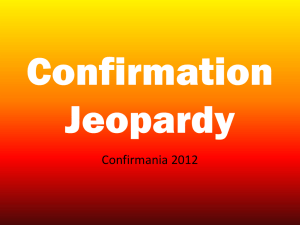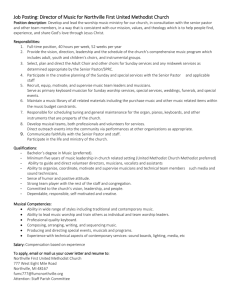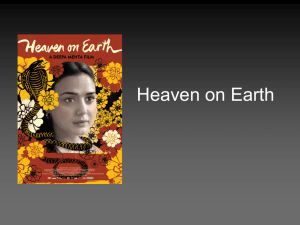FrederickNewsPost.com Descendants of freed slaves fight to keep
advertisement
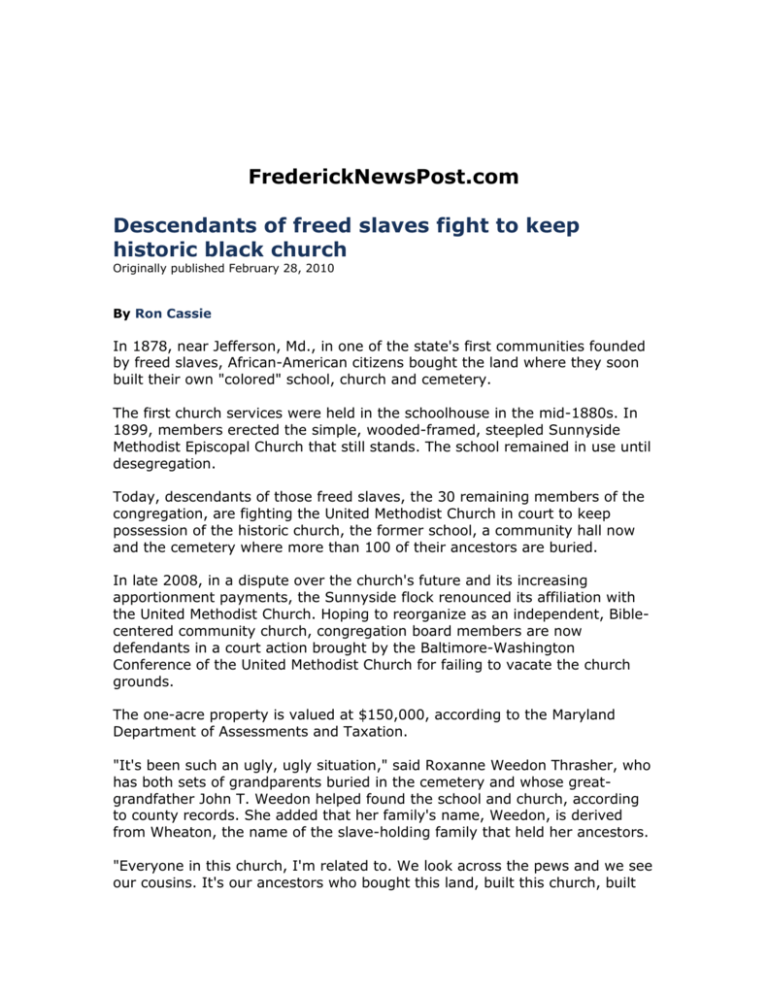
FrederickNewsPost.com Descendants of freed slaves fight to keep historic black church Originally published February 28, 2010 By Ron Cassie In 1878, near Jefferson, Md., in one of the state's first communities founded by freed slaves, African-American citizens bought the land where they soon built their own "colored" school, church and cemetery. The first church services were held in the schoolhouse in the mid-1880s. In 1899, members erected the simple, wooded-framed, steepled Sunnyside Methodist Episcopal Church that still stands. The school remained in use until desegregation. Today, descendants of those freed slaves, the 30 remaining members of the congregation, are fighting the United Methodist Church in court to keep possession of the historic church, the former school, a community hall now and the cemetery where more than 100 of their ancestors are buried. In late 2008, in a dispute over the church's future and its increasing apportionment payments, the Sunnyside flock renounced its affiliation with the United Methodist Church. Hoping to reorganize as an independent, Biblecentered community church, congregation board members are now defendants in a court action brought by the Baltimore-Washington Conference of the United Methodist Church for failing to vacate the church grounds. The one-acre property is valued at $150,000, according to the Maryland Department of Assessments and Taxation. "It's been such an ugly, ugly situation," said Roxanne Weedon Thrasher, who has both sets of grandparents buried in the cemetery and whose greatgrandfather John T. Weedon helped found the school and church, according to county records. She added that her family's name, Weedon, is derived from Wheaton, the name of the slave-holding family that held her ancestors. "Everyone in this church, I'm related to. We look across the pews and we see our cousins. It's our ancestors who bought this land, built this church, built this school, and made all the repairs over the years – never even asking the Methodist Church for a loan," Thrasher said. "Every year, we've paid our apportionment in full. We our very proud people and we know our history." Thrasher's ancestors chose the name of the church from a phrase by one of the founders, who called the church "a light on the sunny side of the mountain." The community came to be called Sunnyside and by 1916 the congregation prospered enough to have paid off the mortgage. That the land is deeded to the Sunnyside congregation board is not in question, said Shaun Lane, spokesman for the Baltimore-Washington Conference of the United Methodist Church. However, according to the United Methodists' Book of Discipline, the denomination's guiding document, "All properties of the United Methodist local churches and other United Methodist agencies and institutions are held, in trust, for the benefit of the entire denomination, and ownership and usage of the church property is subject to the Discipline." In other words, because the church was formed as a Methodist Episcopal Church and has remained a United Methodist Church since 1968, when the Evangelical United Brethren Church joined with the Methodist Church, the Baltimore-Washington Conference claims ownership of the property. Thrasher said the original cause of the dispute involved a district supervisor and former pastor named to lead Sunnyside, part of a four-church charge. Both the district supervisor and pastor, the congregation leadership believed, intended to move the congregation to a larger, nearby United Methodist church and use the Sunnyside property for non-worship purposes. Lane strongly disputed that claim. Thrasher said the Sunnyside leadership feared if the church was shuttered, the property would be sold or fall into disrepair. "Now, because we want to leave, you're telling me you're going to take our property," Thrasher asked rhetorically. "Our families were baptized in that church, married in that church and are buried there." In 2009, Bishop John R. Schol of the Baltimore-Washington conference, in a letter to attorney Thomas Starnes, of the Washington law firm of Drinker, Biddle and Reath, stated that "Sunnyside UMC no longer serves the purpose for which it was organized and incorporated" because the congregation had left the United Methodist Church. Schol stated further, "Therefore, I consent to having the Conference Board of Trustees assume possession and control of all of Sunnyside's property, real and personal, tangible and intangible property." The Baltimore-Washington Conference appears to have Maryland annotated code in its favor. In the 1970s, legislation was passed stating that "all assets owned by any Methodist Church, including any former Methodist Episcopal Church ... shall be held by the trustees of the church in trust for the United Methodist Church." Two efforts at mediation have failed to resolve the conflict, according to Erika Cole, attorney for the Sunnyside leaders. A court date is set for Oct. 19. Coming-of-age milestone Bat mitzvah past age 13 Originally published January 16, 2010 By Ron Cassie Playwright and author Julie Heifetz was raised in a secular Jewish household in St. Louis in the 1950s and early '60s. "We were first generation (American Jews) when it was 'not cool,' to be Jewish," she said "There were no prayer markers on the door, nothing that called attention to Jewishness." Her family attended a temple that reminds her, looking back, of Protestant services, complete with organ and choir situated in a rear loft. Little Hebrew was spoken and the rabbi did not wear a robe. "Very much an assimilated practice," said Heifetz. But she did have one very observant grandfather. Arriving in the United States in the late 1800s, Joe Waltuch, an Austrian immigrant, lived on a reservation in Broken Bow, Okla., for 26 years, selling dry goods to American Indians before moving his family and school-age children to nearby Missouri. "He was such a joyous person, always seeing the best in every person," Heifetz said. "He didn't leave the reservation because he was unhappy -- he loved it there -- he just didn't think his children would receive a good education." At her bat mitzvah ceremony last Saturday at Congregation Kol Ami in Frederick, Heifetz wore her grandfather's morning prayer shawl. Like most Jewish women, Heifetz was not given the opportunity 50 years ago to become bat mitzvah -- considered the passage into adulthood and religious life -- at the traditional age of 13. "I never learned anything about Judaism from him," Heifetz said, explaining her reason for becoming bat mitzvah in her 60s. "But I wanted to be more like him. I wanted to claim that understanding of Judaism that he had, that joy and spirituality." A former writer in residence at the St. Louis Center for Holocaust Studies, Heifetz recalls stories of her grandfather bringing bagels and lox from buying trips to share with his customers. "I tell people my grandfather spoke English the same as he spoke Choctaw -with a Yiddish accent." Although the reasons vary for going through the rigorous bat mitzvah preparation, learning to read Hebrew and studying the Torah, more women later in life are participating in adult bat mitzvah ceremonies across the United States, said Rabbi Dan Sikowitz, of Kol Ami Congregation. "It's unusual, but it's not rare anymore," he said. "These women didn't have the chance. In more traditional congregations, it was just not traditional, since girls were not regarded to have to do the commandments." There are 613 commandments in Judaism, Sikowitz said, not just 10, including learning the Torah, memorizing prayers and blessings for the dead, lighting candles in the sanctuary, and keeping a kosher kitchen. Sikowitz added the eldest daughter of a New York rabbi -- Judith Kaplan Eisenstein -- was the first woman in the 1920s to become bat mitzvah in the U.S. Joining Heifetz in becoming bat mitzvah Saturday were Frederick Alderwoman Karen Young and Jennifer Mykytyn, former vice president of Junior Achievement of Central Maryland. Both women, like Heifetz, are decades past the traditional age. Each had her own reasons for going through the process, but all three said they thought the best thing about it was the friendship they formed. "I think it's always something I've been interested in," said Young, who grew up in a secular household in Montoursville, Pa. "Mainly, it was an intellectual pursuit. The knowledge and experience is something I've always wanted to have." She also mentioned as part of her D'var Torah, a mini-sermon each bat mitzvah gives, that she hoped her effort may serve as a model down the road for her younger sister who has a 15-month-old child. "That was central to my message," said Young, who credited Sikowitz's flexibility in working with women with still very busy lives, during almost two years of biweekly, then weekly classes. "I take a very holistic approach to Judaism. The chance to do this was about spirituality, but also about maintaining the Jewish heritage." For Mykytyn, becoming bat mitzvah "was probably about many things." "I've been thinking about this for a while," she said. "I was afraid, for one, about learning to read Hebrew, which has different symbols. It's not like learning another language with our same alphabet -- and I was worried about learning the Torah, which doesn't have vowels." Ultimately, it was her son's accidental death in early 2008, that moved her to finally act. Two years before, Mykytyn, who is not from Frederick, had joined the Kol Ami congregation. Sikowitz had been instrumental in helping her and her husband through the arrangements and grief after they lost their son, she said. "He walked us through it," Mykytyn said. After that experience, she said, bat mitzvah "seemed like the next step." Mykytyn said both her parents were Jewish, but like Heifetz, added that growing up in the '50s, being Jewish was "not cool." "You gain your own fortitude, however, when you get older," she said. "For some, I think, too, you get closer to some sort of spirituality when you get older." Mykytyn laughed, adding that she also wanted to get out the "cobwebs," by proving she could learn the material. And she said she wanted to show her other son something. "I wanted him to see how I was embracing Judaism," she said. ***Note: The following story was reported from Haiti, where I accompanied a local Frederick doctor soon after the earthquake. Aid workers recall ordeal in Port-Au-Prince rubble January 27, 2010 By Ron Cassie PORT-AU-PRINCE, Haiti - Sarla Chand saw the chandelier in the lobby of the Hotel Montana moving and knew immediately what was happening. "I have experienced earthquakes before, in India," said Chand, 65. "I was two or three steps behind everyone else in our group and I am sure they saw it, too. The next thing I knew, I had lost my balance and found myself in the dark. I don't know how long it was before I realized I had been hit in my head and may have broken my ribs. "It was pitch dark, and it felt like my legs were trapped." Chand, a relief administrator from IMA World Health in New Windsor, Md., was in Haiti with co-workers Rick Santos and Ann Varghese. They were not staying at the five-story, 145-room Hotel Montana, but were waiting to meet two United Methodist Church ministers and a lay volunteer there on Jan. 12 when the 7.0-magnitude earthquake hit. "We were sitting in the lobby, and they were running late. When they arrived we got up to go to the restaurant," Chand said. "That's as far as we got; we were walking past the front desk. I don't think we fell into a lower level -- it was that the hotel had collapsed on us." Chand, Santos and Varghese were rescued by a French team more than two days later. After taking a week off to recover, Chand and Varghese are back at work. "Definitely a miracle," said Carol Hulver, an IMA World Services assistant to Santos, the organization's CEO and president. Chand, who holds a doctorate in human services research and evaluation from Cornell University, is vice president of the IMA International Program. Varghese is an officer for neglected tropical diseases. IMA World Health, formerly Interchurch Medical Assistance, is a nonprofit, faith-based organization that provides health care services and supplies to vulnerable communities, primarily in the developing world. Along with their own efforts, they also partner with organizations such as Lutheran World Relief, the Episcopal Church, the Presbyterian Church, Church of the Brethren and United Methodist Church, delivering those churches' overseas cargo to their particular mission efforts. Under the Montana About 300 people – employees, American, Canadian and European foreign aid workers and guests –were in the terraced hotel when it collapsed two weeks ago. Two-thirds are feared still buried under the wreckage. A "Haiti Earthquake Hotel Montana" Facebook page seeking support and prayers for those still missing family has attracted 15,000 friends. Three Methodist ministers were trapped in a 3- by-8-foot enclosed space with Santos and Varghese. Two of them did not survive. The Rev. Sam Dixon, 60, of Raleigh, N.C., head of the United Methodist Committee on Relief, died before he could be pulled from the Montana. The Rev. Clinton Rabb, 61, a missionary from Westchester County, N.Y., married with eight children, organized volunteer programs in Third World countries. His legs were amputated to remove him from the rubble, according to reports, and he died after being flown to Florida for treatment. James Gulley, 64, a Methodist mission worker from Colorado, survived. Chand, 65, was separated from the rest in her own small enclosed area, with about 4 feet of clearance between the floor below and wreckage resting precariously above her. Santos and Varghese had their cell phone and laptops. They could use their lights and track the passing days, but were unable to send a message for help. Chand lost her purse and belongings in the fall and could not see anyone. However, she was able to talk to the others from her group -- as well as two men trapped in separate elevators nearby. "As the hours kept passing, it got pretty difficult, thinking maybe we couldn't last much longer," said Varghese, 31. "It was really quite difficult with Sam and Clinton in there _with us." "We made it only by the grace of God." Rescue and return Chand, who had more wiggle room than the others, first heard voices coming from the outside. She and others began screaming for help. "I heard voices, yet nothing happened," Chand said. "I thought we were going to have to spend another night." Then she heard a response. "I heard someone coming closer yelling, 'Help, help,' and I yelled back, 'Are you looking for help or here to help?'" Chand said. She found a small hole and stuck her leg out to show where she was. "Then he said he'd be back and left." Chand was rescued around 11 p.m. Jan. 14. It took four more hours to free Santos and Varghese, and Rabb was extricated 15 hours after Santos. Varghese said she, Chand and Santos were severely dehydrated when they were rescued. They suffered no injuries beyond cuts and bruises. Chand had a gash on her head and lost some blood. Chand called her two sons, who are 28 and 26 and live in Teaneck, N.J., to let them know she was all right. They had no idea she was under the Montana. The IMA group had been staying at the Prince Hotel, which did not fall in the quake. Chand said her strong faith carried her through the ordeal. "I am claustrophobic. I kept praying and praying and I was able to stay focused. I did not even think about it," she said. Since returning to the U.S., Chand and Varghese have found it difficult to watch television coverage of the rescue efforts and overwhelming humanitarian problems in Port-au-Prince. "I have seen some of the recovery effort on television, but I have to limit myself," Varghese said. However, given the tremendous need for food, water and shelter, she said, it is important that the media remain focused on the crisis. "I can't watch," Chand said. "But I think about it all the time. And now I have to begin planning how to bring a relief effort to Haiti."
